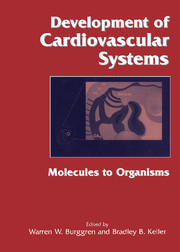Book contents
- Frontmatter
- Contents
- List of contributors
- Foreword by Constance Weinstein
- Introduction: Why study cardiovascular development?
- Part I Molecular, cellular, and integrative mechanisms determining cardiovascular development
- Part II Species diversity in cardiovascular development
- 9 Evolution of cardiovascular systems: Insights into ontogeny
- 10 Morphogenesis of vertebrate hearts
- 11 Invertebrate cardiovascular development
- 12 Piscine cardiovascular development
- 13 Amphibian cardiovascular development
- 14 Reptilian cardiovascular development
- 15 Avian cardiovascular development
- 16 Mammalian cardiovascular development: Physiology and functional reserve of the fetal heart
- Part III Environment and disease in cardiovascular development
- Epilogue: Future directions in developmental cardiovascular sciences
- References
- Systematic index
- Subject index
14 - Reptilian cardiovascular development
from Part II - Species diversity in cardiovascular development
Published online by Cambridge University Press: 10 May 2010
- Frontmatter
- Contents
- List of contributors
- Foreword by Constance Weinstein
- Introduction: Why study cardiovascular development?
- Part I Molecular, cellular, and integrative mechanisms determining cardiovascular development
- Part II Species diversity in cardiovascular development
- 9 Evolution of cardiovascular systems: Insights into ontogeny
- 10 Morphogenesis of vertebrate hearts
- 11 Invertebrate cardiovascular development
- 12 Piscine cardiovascular development
- 13 Amphibian cardiovascular development
- 14 Reptilian cardiovascular development
- 15 Avian cardiovascular development
- 16 Mammalian cardiovascular development: Physiology and functional reserve of the fetal heart
- Part III Environment and disease in cardiovascular development
- Epilogue: Future directions in developmental cardiovascular sciences
- References
- Systematic index
- Subject index
Summary
Introduction
Little is known of cardiovascular development in reptiles, despite their important place in evolutionary history. Three main factors have contributed to the neglect of these animals in developmental research. First, reptiles were not commonly bred in captivity until recently, and embryos were available only by retrieval from the field. This approach to obtaining specimens leads to problems of inadequate supplies of material and problems in timing of developmental events, especially regarding fertilization dates and thermal incubation histories. Second, unlike avian embryos, the chorioallantois of reptiles adheres tightly to the overlying eggshell membrane within the first few days of development, making invasive procedures difficult without incurring excessive blood loss. Third, reptiles have extended development times relative to birds and most mammals, 450 days in the most extreme case, which is a time course to tax the most patient of investigators. The large array of developmental pathways available to reptiles suggests there may not be a standard reptile developmental timetable. Not only is there a huge range of developmental times, but there are also many types of eggshells (e.g., low and high permeability) and different reproductive modes (i.e., viviparous, ovoviviparous, and oviparous).
Recently, however there has been a resurgent interest in reptile embryos and their physiology. Indeed, one of the “drawbacks” of studying reptilian embryos, the long incubation period, may prove a boon to some types of developmental investigations. For those interested in the timing of developmental events, the 21-day incubation period of the domestic fowl (even less for many fish and amphibians) limits the resolution with which certain events, especially those at the initiation of circulation, can be timed.
- Type
- Chapter
- Information
- Development of Cardiovascular SystemsMolecules to Organisms, pp. 183 - 192Publisher: Cambridge University PressPrint publication year: 1998



